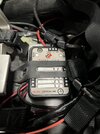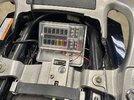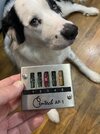It offers only one or two circuits (depends on the model) and they are protected at, iirc 20 amps.
16 amps. I agree with you that this is on the low side- I don't think that this is even high enough to run two Fiamm horns. I prefer to have the option of a higher capacity circuit if I want it. It also only gives you one or two additional circuits, depending on the version, which is not very much. If I am going to go to all of the trouble of connecting up a secondary fuse block I certainly am going to choose a fuse block that offers more circuits than that.
If you 'blow' the fuse and have to reset it, Healtech says to remove the wire from the battery for a few seconds and replace it. I think this is cumbersome and not user friendly.
It allows an over-current for a maximum of .002 seconds before disabling the circuit, which is a good feature. If it does disable the circuit due to an excessive current draw it will reset itself with no outside intervention and restore power if the excessive draw is no longer present. It will attempt this three times before it permanently disables the circuit requiring the reset procedure that you outlined. Rather cool tech I suppose but I agree with you again, I'm not convinced that I wouldn't prefer a standard fuse.
The thunderbox is electronically switched on when you turn on the ignition with no additional wiring - a benefit. It is also a very small parasitic load - another negative.
It draws 1 M.A. in standby mode. If not used it remains in this mode for 24 hours after which it turns itself off completely eliminating the drain, so not really a concern.
To Mello Dude:
Below are some of things that I discovered that I needed to decide about in order to determine what features I needed in a fuse block. Once you have decided what you need/want you can go about eliminating the fuse blocks that do not offer those features.
- How many additional circuits do you want? You mentioned 6. The greater the number of circuits the fewer the choices there are.
- Do you want it to have an integrated switching relay to power on or do you prefer to have a seperate switching relay that you wire in yourself?
- Do you want some of the circuits to be always on instead of being switched? Some offer this option for the purpose of connecting a battery tender, or a phone charger as an example.
- Do you want to be able to easily alternate some of the circuits between always on and switched? Some offer this feature. I'm not sure of its usefulness as I don't know why I would want to switch the same circuit back and forth between always on and switched but it is an option that is available.
- Do you want the fuse box to have both power and ground feeds? Many only offer power feeds and the ground circuit is through the motorcycles' existing ground circuit. Others have dedicated ground connections at the fuse box. This means that every accessory has to have two wires run to it from the fuse block, one for 12V+ and one for 12V-. The ST1300's electrical system is known to have a ground system that does not have much excess unused capacity available, so running dedicated ground circuits directly back to the fuse block is not a foolish idea.
- Do you want it to be waterproof? i.e. Actually rated waterproof as opposed to water resistant. Some are, most are not. I have never read of a fuseblock failure related to moisture, so I don't consider this a deciding factor.
If you can decide on which features are absolute must haves you can then narrow down your choices by eliminating those that do not offer the features that you want.







